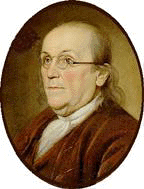Benjamin Franklin's Will - 7 News Article Web Readings
 Each underlined phrase represents a link that you
should read through on the web.
Each underlined phrase represents a link that you
should read through on the web.
In the
Benjamin Franklin lab,
you solved for the average earned
interest rates after the first and second hundred years.
In the following readings, you will learn what happened to the funds in
real life by reading reports, articles and research that I
have compiled for you.

Benjamin Franklin's Life and Will
Read through this
Reading 1: summary of Benjamin Franklins's life and will [3]
and then read the
Reading 2:
actual codicil in Benjamin Franklin's will [2].
The Funds in Boston and Philadelphia
Unfortunately, it was not always possible to find as many borrowers as
Franklin had planned and there were other problems as well.
Skim over some of the
Reading 3: problems that the Philadelphia
and Boston funds faced as of 1837 [2].
In January 1894, at the end of 100 years from the inception of the
Franklin gift, because of these problems, the Boston fund had grown from
$4444.44 dollars (the equivalent of $1000 pounds) to $391,000 dollars.
(Note that while this is less than the $582,221.64
(the equivalent of 131,000 pounds) that Franklin had imagined,
it is significantly more than Philly's earnings because
Boston gave up on Franklin's loan scheme and played the stock market.)
Reading 4:
After legal battles in Boston (and some in Philadelphia too)
[3],
3/4 of this money (about $300,000 US)
was used to fund the
Franklin Institute of Boston, and the remainder,
about $100,000 US, was maintained for loans for the 2nd century.
By 1907, the Benjamin Franklin Fund in Philadelphia totaled $172,350,
less than a fourth of what Franklin had projected. Of that sum,
$133,076 was transferred to the Franklin Institute, a hands-on
science education museum.
This
Reading 5: Philadelphia Inquirer article
by Clark De Leon [1]
from February 1993
that
describes the situation in Philadelphia and Boston at the end of the second
hundred years. It also gives
some interesting insights into contemporary city government. (See
my update in red.)
Also see this
Reading 6: Boston Globe article
by Patricia Nealon [5] from December 1993 that describes a court
decision on the Boston fund. (See my update in red.)
And finally, take a look at
Reading 7: What "Miracle of Compound Interest"?
[6]
List of References for Your Project
Here are the full references for the above links--you can paste this in.
You may also use
additional references,
but no others are required. Make sure to acknowledge any pictures you use.
- De Leon, Clark, Divvying Up Ben: Let's Try for 200 More,
The Philadelphia Inquirer, 1993.
A newspaper article that
describes the situation in Philadelphia and Boston at the end
of the second hundred years.
- Franklin, Benjamin, Ben Franklin's Will - Note by the Editor,
Independence Hall Association,
electronically publishing as ushistory.org, 1999.
Benjamin Franklin's will and codicil includes his instructions,
motivation and wishes for the creation and disposition of the funds.
The note by the editor contains information of the fund as of January 1, 1837
- Franklin Institute of Boston, About FIB - A Long History,
A web page that describes the history of the Franklin Fund
in Boston and the creation of the Franklin Institute after the end of the
first hundred years. This also contains some additional background
on Benjamin Franklin.
- Greenwald, Sarah J, Math 1010 lab, updates and
private communication, 2011.
- Nealon, Patricia,
Ben Franklin Trust To Go To State, City, Not School,
SJC Says, The Boston Globe, 1993.
A newspaper article that describes a court decision on the Boston fund
at the end of the second hundred years.
-
What "Miracle of Compound Interest"? -
How Ben Franklin's best laid plans came a cropper, Philanthropy Magazine,
The Last Page,
August/September 2001.
Includes a summary of the history of the funds.
 Each underlined phrase represents a link that you
should read through on the web.
Each underlined phrase represents a link that you
should read through on the web.
